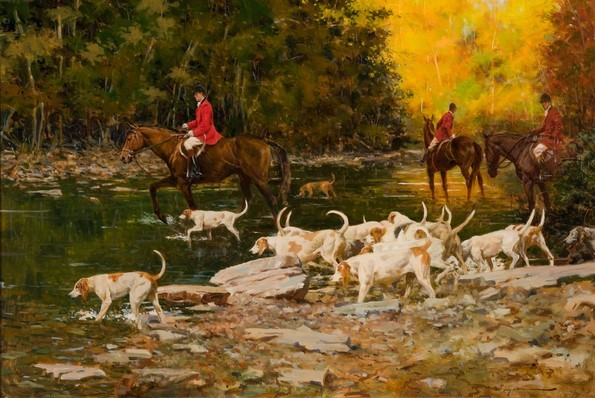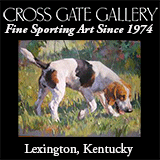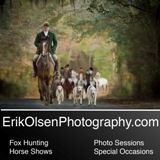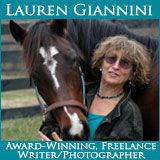Art & Literature
11th Annual Sporting Art Auction at Keeneland
The Eleventh annual Sporting Art Auction at the Keeneland Sales Pavilion in Lexington, Kentucky, was held last fall. The event was a cooperative venture between the world’s largest Thoroughbred auction house and its Lexington, Kentucky neighbor, Cross Gate Gallery, a leading dealer in the world’s finest sporting art.
Read More
A Funny Thing Happened
 "A Funny Thing Happened On The Way To The Fox Den", by J. Harris Anderson.
"A Funny Thing Happened On The Way To The Fox Den", by J. Harris Anderson.
“Well Done, Chaps!”
 "Well Done, Chaps!" by Cathy Antkes Choyce.
"Well Done, Chaps!" by Cathy Antkes Choyce.
Cathy Antkes Choyce drew this wonderful scene, showing those “invisible tethers” that tie a hound to the huntsman.
Crossing the Country to Help our Huntsman Exercise Hounds

Our horses in the gooseneck,
We’re in this capsule of a truck cab
Headlights probing thick fog, hurtling through time
And space between white and double yellow lines.
Good way to hit a deer, he says. They move around
this time of morning.
Foxhunting’s Influence on the Mounted Soldier
Book Review by Matthew Biscotti
 Riding to Arms: A History of Horsemanship and Mounted Warfare, Charles Caramello, University Press of Kentucky, 2022, Horses in History Series, illustrated, hardcover and digital, 279 pages, $34.95 (list)
Riding to Arms: A History of Horsemanship and Mounted Warfare, Charles Caramello, University Press of Kentucky, 2022, Horses in History Series, illustrated, hardcover and digital, 279 pages, $34.95 (list)
Charles Caramello’s Riding to Arms: A History of Horsemanship and Mounted Warfare is a thorough and erudite treatise on the evolution of the subject. Though the horse is no longer critical in warfare, much of this literary history describes principles of riding and instruction that laid the foundation for the theory and practice of riding today.
Turned Out
The author sat in the viewing room above the arena waiting for her daughter and the instructor to appear for the weekly lesson. A groom led a horse into the empty arena and released it for a few minutes of turnout. The horse’s antics inspired Jennifer’s poem.
"Life jolts us at certain moments," she says.

We are never truly free
but tell that to the horse
who on a Saturday morning
has a few minutes to himself
in the pasture
just for the purpose of
thundering
in his moment
to do whatever wild thing
he has conceived
in the early half-light.
The Flying Change
The best description of the flying change―the mechanics and the moment―I have ever read. Riding instructors should give a copy of this poem to their students to study before even explaining how to achieve the maneuver.
 The moment of suspension during the flying change in which the horse changes his lead on the fly from one lead to the other, left-to-right or vise versa. The horse can initiate the flying change on its own, generally as it changes direction at the canter, or the trained rider may induce the horse to change its leads at any given moment.
The moment of suspension during the flying change in which the horse changes his lead on the fly from one lead to the other, left-to-right or vise versa. The horse can initiate the flying change on its own, generally as it changes direction at the canter, or the trained rider may induce the horse to change its leads at any given moment.
1
The canter has two stride patterns, one on the right
lead and one on the left, each a mirror image of the
other. The leading foreleg is the last to touch the
ground before the moment of suspension in the air.
On cantered curves, the horse tends to lead with the
inside leg. Turning at liberty, he can change leads
without effort during the moment of suspension, but
a rider’s weight makes this more difficult. The aim of
teaching a horse to move beneath you is to remind
him how he moved when he was free.
Adam Lindsay Gordon (1833−1870)
 Adam Lindsay Gordon, c. 1860
Adam Lindsay Gordon, c. 1860
English-born Adam Lindsay Gordon was a maverick. At least from the standpoint of a series of boarding schools through which he passed, having been shipped off from home at the age of seven. At age nineteen, he was again shipped off, this time to Australia. His father hoped his son would find a fresh start.
Adam's life was short but active. He was an exceptional horseman. After arriving in Australia, he joined the mounted police. He trained and rode steeplechasers, never shrank from a dare, was elected to Parliament, and is considered one of Australia's finest poets. A statue of Gordon was erected in Melbourne, near Parliament, bearing these words from his poem, "Ye Wearie Wayfare."
"Life is mostly froth and bubble
Two things stand like stone,
Kindness in another's trouble
Courage in your own."
What follows is a toast by Gordon, written to be sung. The first line is especially familiar to foxhunters when raising a glass. With apologies, I must admit that this toast was pretty much written for the men’s bar.
Folk Tails: The Japanese Fox

At the National Sporting Library & Museum, there are over twenty-thousand books on foxhunting, horse racing, fishing, field sports, and other related topics. In my first few weeks as a Visitor Services Associate, I found what was probably the last thing I thought I’d see on the shelves: a book on kitsuné.
Kitsuné: Japan’s Fox of Mystery, Romance, and Humor by Kyoshi Nozaki is a delightful read for anyone who enjoys learning about the fox in Japanese culture or who likes folklore and mythology. This book contains many stories from legend, literature, theatre, and fairytales about the Japanese fox.
Tradition and the Individual Talent
 Pulitzer Prize-winning American poet, Henry Taylor
Pulitzer Prize-winning American poet, Henry Taylor
An old-school foxhunter let it get around
that he hunted a deer-proof pack. Hard to believe:
foxhounds are born to run foxes, all right,
but you have to make them stay off rabbits,
housecats, chickens, etc. They learn to stop
when the hound-whip cracks. Deer scent, though,
is strong enough to put whips out of their minds.




















